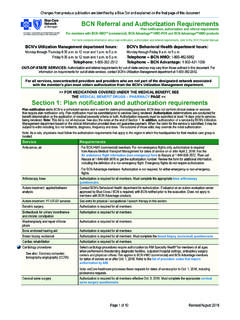Transcription of THE ENDOSCOPICALLY ABNORMAL ESOPHAGUS …
1 THE ENDOSCOPICALLY ABNORMAL ESOPHAGUS The endoscopic abnormalities that may be seen in association with esophageal disorders are numerous, varying from subtle alterations in the esophageal mucosal surface to large ulcers or masses. This discussion will be focused on a few commonly encountered entities in which clinical, endoscopic and histologic correlation are critical for establishing a correct diagnosis . These include gastroesophageal reflux disease (GERD), eosinophilic esophagitis and Barrett s ESOPHAGUS . gastroesophageal Reflux Disease The most recent practice guidelines for diagnosis and management of gastroesophageal reflux disease support establishing a presumptive diagnosis of GERD without endoscopic evaluation in the setting of typical symptoms such as heartburn and regurgitation (1).
2 Empiric medical therapy with a proton pump inhibitor is recommended; therefore, most patients that are being evaluated for GERD ENDOSCOPICALLY are already on PPI therapy at the time of biopsy. Endoscopic examination is recommended in any patient with alarm symptoms, or in those at high risk for development of complications. Alarm symptoms include dysphagia, non-cardiac chest pain, or a lack of a response to PPI therapy. Although the presence of GERD-related symptoms does not provide a high level of sensitivity or specificity for predicting esophageal abnormalities on upper endoscopy, it may be reasonable to screen select individuals for Barrett s ESOPHAGUS by endoscopy.
3 Epidemiologic risk factors for BE have been well established and include age over 50, symptoms for > 5-10 years, obesity, and male sex. Recent data suggest that selectively screening patients that fall into this high risk group may be reasonable (2) . The endoscopic appearance of the ESOPHAGUS varies with disease severity. Approximately one third of patients with chronic GERD symptoms are ENDOSCOPICALLY normal (3). Areas of patchy erythema and red streaks are the first endoscopic abnormalities. Later erosions and ulcers develop; these predominate distally and taper off proximally. As the disease progresses, the ulcers become confluent, even circumferential.
4 Strictures or BE characterize severe chronic disease. Several endoscopic classifications have been developed to evaluate the esophageal mucosa. The two most common are the Savary-Miller MUSE system and Los Angeles classifications (4,5). The use of these grading systems among gastroenterologists varies, likely depending on the practice setting. Among esophageal biopsies seen in our practice in 2010, included an LA grade, and a Savary-Miller grade (6). Savary-Miller Classification Grade Features I One or more supravestibular reddish spots with or without exudates II Erosive and exudative lesions in the distal ESOPHAGUS that may be confluent, but not circumferential III Circumferential erosions in the distal ESOPHAGUS covered by hemorrhagic and pseudomembranous exudates IV Presence of chronic complications such as deep ulcers, stenosis, or scarring with Barrett s metaplasia Los Angeles Classification Grade Features A One or more mucosal breaks 5 mm in length B At least one mucosal break > 5 mm long.
5 But not continuous between the tops of adjacent mucosal folds C At least one mucosal break which is continuous between adjacent mucosal folds, but not circumferential (< 75% of periphery) D Mucosal breaks that involve at least three-quarters of the luminal circumference Note: Ulcers, strictures, Barrett s metaplasia, and other findings are reported as an adjunct to each grade. Reflux Esophagitis GERD affects patients of all ages, even children and small infants, but is most common among patients over age 65 (7). GERD affects from 3% to 4% of the population, and its incidence has increased in the past few decades.
6 The annual cost of managing the disease in the United States is estimated at 9 billions dollars (8). GERD is equally present among men and women, but there is a male predominance of esophagitis and Barrett ESOPHAGUS . GERD affects whites more frequently than members of other races. Conditions predisposing to GERD include smoking, decreased physical activity, increased intra-abdominal or intragastric pressure, including pregnancy, ascites, body mass index and obesity; and delayed gastric emptying. Postmenopausal estrogen therapy has been associated with GERD symptoms (9, 10). Motility disorders including diabetes, alcoholic neuropathies, and scleroderma also predispose to GERD.
7 Patients with hiatal hernias and strictures are especially prone to develop GERD. It also follows surgical procedures. Clinical Features Transient mild reflux affects most individuals including children and adults. The degree of reflux must be severe for individuals to become symptomatic. Adults present with diverse symptoms including heartburn, regurgitation, bitter-tasting fluid in the mouth, dysphagia, odynophagia, nausea, vomiting, hiccups, anginalike chest, and hoarseness. The regurgitation can cause a spectrum of conditions, including asthma, chronic cough, chronic laryngitis or pharyngitis, subglottic stenosis, and dental disease.
8 Rare patients present with bleeding from esophageal ulcers. Complications peak between ages 50 and 70 years (11). As discussed above, the majority of patients with GERD symptoms are treated with proton pump inhibitor (PPI) therapy, often prior to being seen by a gastroenterologist (12). A recent survey found, however, that as many as 40% of patients receiving PPI treatment have residual symptoms (13). As a result, many of the patients undergoing endoscopy and biopsy for GERD symptoms are those that are refractory to PPI therapy. Such patients may have additional disorders superimposed on GERD.
9 The differential diagnosis of esophageal disorders that may be associated with refractory symptoms in patients treated with PPIs is summarized below. Disorders Associated with Residual Symptoms in Patients Treated with PPIs Esophageal Disorders Reflux Related Incorrect medication dose timing Medication non-compliance Residual pathologic acid secretion Rapid PPI metabolism Hypersecretory state Anatomic abnormalities Defective LES function Hypersensitivity of ESOPHAGUS to small amounts of refluxed material Non-reflux related Achalasia Esophageal spasm Scleroderma Eosinophilic esophagitis Pill esophagitis Infectious esophagitis Non-Esophageal Disorders Gallbladder disease Cardiovascular disease
10 Musculoskeletal disorders Malignancy (GI and non-GI) Histologic Features Biopsies are performed to confirm the diagnosis of GERD; to document complications, including esophagitis, BE, or tumor development; and to rule out the presence of coexisting infections. Since esophagitis tends to be a patchy process, it is easy to miss diagnostic changes on a single biopsy. The current wisdom is that biopsies should be taken in the area just distal to the Z line to detect carditis (see below), just proximal to the Z line to detect esophagitis, and 3 cm proximal to the Z line to detect the hyperplastic changes that are more predictive of the presence of GERD than more distally derived biopsies.


